Git Flow

In the world of software development, efficient collaboration and version control are paramount. Git, a distributed version control system, has become the de facto standard for managing source code. Among the various workflows that have emerged to harness Git’s power, one of the most popular and widely adopted is Git Flow. In this comprehensive guide, we will delve into the intricacies of Git Flow, its principles, its workflow, and its benefits for teams striving for organized and streamlined development processes.
Understanding Git Flow:
Git Flow is a branching model designed to optimize collaboration, release management, and code stability within a project. It was introduced by Vincent Driessen in 2010 and has since gained immense popularity due to its clear structure and ease of implementation. At its core, Git Flow revolves around the idea of leveraging Git’s branching capabilities to facilitate parallel development, feature isolation, and smooth release cycles.
Key Concepts of Git Flow:
-
Main Branches:
- master: This branch represents the stable production-ready code. It should only contain thoroughly tested code that is ready for deployment.
- develop: The integration branch where ongoing development occurs. It serves as a staging area for features before they are merged into the master branch.
- Supporting Branches:
- feature branches: These branches are created off the develop branch and are used for developing new features or enhancements. Once a feature is complete, it is merged back into the develop branch.
- release branches: Created from the develop branch, release branches facilitate preparation for a new production release. They allow for final adjustments, bug fixes, and version bumping before merging into master and develop.
- hotfix branches: Spawned from the master branch, hotfix branches are used to quickly address critical issues in production code. Once fixed, changes are merged into both master and develop branches.
Git Flow Workflow:
- Initialize Git Flow: Start by initializing Git Flow in your repository using the
git flow initcommand. This sets up the main branches and establishes the workflow. -
Feature Development:
- Create a new feature branch using
git flow feature start <feature-name>. - Implement the feature, commit changes, and push the branch for collaboration.
- Once the feature is complete, finish the feature using
git flow feature finish <feature-name>, which merges changes back into the develop branch and removes the feature branch.
- Create a new feature branch using
-
Release Management:
- Begin a new release using
git flow release start <version>. This creates a release branch from the develop branch. - Perform final adjustments, bug fixes, and version bumping on the release branch.
- Once ready, finish the release with
git flow release finish <version>. This merges changes into both master and develop branches, tags the release, and removes the release branch.
- Begin a new release using
-
Hotfix Handling:
- Address critical issues by creating a hotfix branch from the master branch (
git flow hotfix start <version>). - Implement fixes, test thoroughly, and merge changes back into both master and develop branches using
git flow hotfix finish <version>.
- Address critical issues by creating a hotfix branch from the master branch (
Benefits of Git Flow:
- Clear Structure: Git Flow provides a clear and consistent structure for managing branching and code deployment, making it easier for teams to understand and follow.
- Isolation of Features: By creating feature branches, Git Flow enables developers to work on features independently without interfering with the main codebase until ready.
- Release Stability: With dedicated release branches, Git Flow ensures that release preparation and bug fixing can be done without disrupting ongoing development.
- Versioning Control: Through version tagging and branching strategies, Git Flow helps maintain a clear history of releases and facilitates easy rollbacks if needed.
Conclusion:
Git Flow offers a robust framework for managing collaborative development projects effectively. By adhering to its principles and workflow, teams can streamline their development processes, enhance code stability, and ensure smoother release cycles. While Git Flow provides a solid foundation, it’s essential to adapt and tailor the workflow to fit the specific needs and dynamics of each project. Embracing Git Flow empowers teams to harness the full potential of Git for efficient and organized software development.





